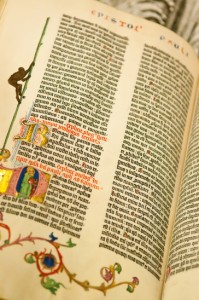 Most bible readers have never given much thought to how the book they (hopefully) read and revere came to be. They think not much about translation or the issues related to it, and they think even less about the texts that came to be translated. The time between the writing of a biblical text at the hand of a David or a Paul and the arrival of an NRSV into the pew holder before them is something of a black hole.
Most bible readers have never given much thought to how the book they (hopefully) read and revere came to be. They think not much about translation or the issues related to it, and they think even less about the texts that came to be translated. The time between the writing of a biblical text at the hand of a David or a Paul and the arrival of an NRSV into the pew holder before them is something of a black hole.
How did the texts get passed down through the ages to be translated in the first place? What were these texts? How were they preserved? These questions fall within the purview of what is technically called lower or textual criticism. While the study of text criticism doesn’t find its way onto the bucket list of many, it is worth learning a little about for a couple of reasons.
Reason #1 is that people assert all sorts of daft things about the bible. There are numerous occasions when the accuracy of the scriptures are challenged. One I hear often is that the stories of the bible circulated in some sort of loose oral tradition for hundreds of years before they were written down. Another is that Moses (or the disciples, or whoever) were illiterate and couldn’t have written these things down. The Bible is assumed to be a haphazard book thrown together from hearsay and old wives tales long after the events described. This stuff is way off. The more you understand the way we actually received the scriptural documents, the better you’ll be able to answer these sorts of ridiculous challenges.
Reason #2 is that when you actually understand the way the scriptural documents were passed down, you will be enormously encouraged. Not only need we fear no embarrassment in this regard, we should be immensely enheartened to learn of the meticulous care of the devoted servants who preserved these texts for us. We are likewise filled with greater confidence when we see the providential care of the God who oversaw the transmission of these valuable documents throughout church history. Any believer who studies this will hold the Bible in greater awe and will believe and proclaim its message with increased assurance.
When we talk about a Bible translation like the ESV, we are talking about the translation of an original language document. The meaning of the Greek or Hebrew has had its meaning brought over into English so we can decipher it. But what about that original language document – the Hebrew of the Old Testament and the Greek of New Testament? Is that Hebrew document the very one that Moses or Jeremiah wrote? Is that Greek document the very one that Paul or Matthew wrote?
Nope. What we have are copies of the original documents. Actually, what we have are copies of copies of copies of copies of copies (you get the idea) of the original documents. These original documents (which we don’t have) are often referred to as the autographs. This refers not to the signatures of important people, but to the (for example) actual piece of papyrus upon which Paul or his scribe wrote the epistle to the Philippians. How can we be sure that the Hebrew and Greek that serves as the basis of the translation that we read accurately reflects what the original autographs said?
Well that’s where text criticism comes in. I’ll explain text criticism in the next two blog entries here. One on the Old Testament Hebrew manuscript tradition, and one on the New Testament Greek manuscript tradition.